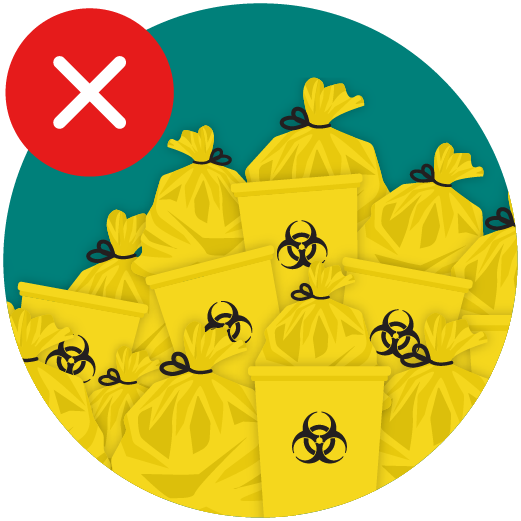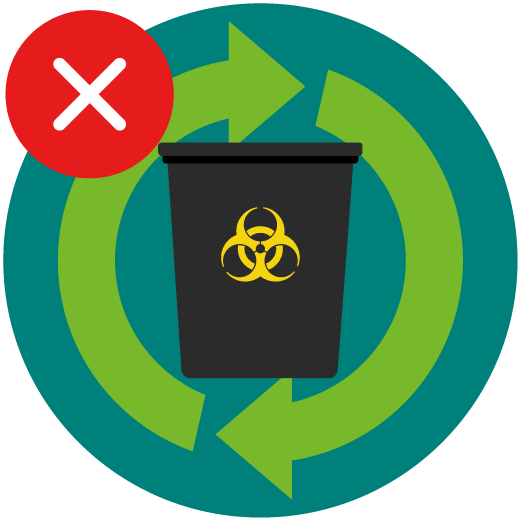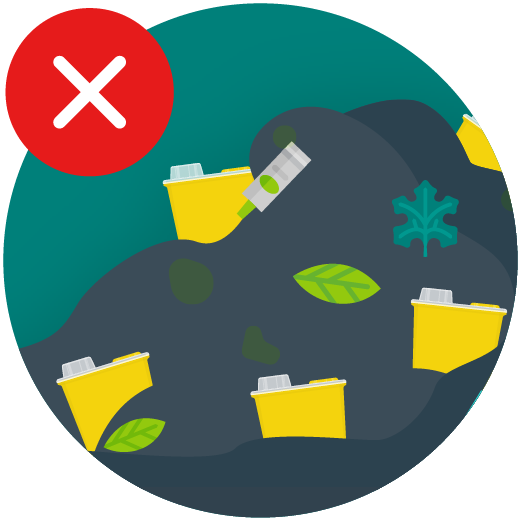5 Healthcare Waste Myths Debunked

There is no shortage of myths when it comes to healthcare waste in Canada. Unfortunately, these inaccuracies can lead to a host of negative consequences, including the improper segregation of waste. When non-regulated waste is included with regulated waste, it can increase waste disposal costs for healthcare facilities and contribute to more emissions being created due to unnecessary over-treatment. See if you’ve heard any of these common waste myths in Canada and learn the truth so your facility can make better choices when it comes to its waste streams.
MYTHS WE WILL DEBUNK
1 / Canadian healthcare facilities must use disposable containers for biomedical waste disposal
2 / All healthcare waste Is hazardous
3 / It’s unsafe to reuse biomedical waste containers
4 / All healthcare waste goes to a landfill
5 / To ensure safe disposal, it’s best to put everything into the biomedical waste container
Myth #1: Canadian healthcare facilities must use disposable containers for biomedical waste disposal
 Many people believe that healthcare facilities are required to use disposable biomedical waste containers due to the possible risk of infection. However, this is absolutely not true. Healthcare facilities are in fact allowed to use reusable containers for biomedical waste, so long as they are properly decontaminated and cleaned after every use.
Many people believe that healthcare facilities are required to use disposable biomedical waste containers due to the possible risk of infection. However, this is absolutely not true. Healthcare facilities are in fact allowed to use reusable containers for biomedical waste, so long as they are properly decontaminated and cleaned after every use.
Government of Canada regulations allow disposable containers to be used for biomedical waste, and the Canadian Standards Association has specific protocols that were developed to ensure safety.
With Daniels, there’s no need to worry about cleaning, since once removed from your facility, our reusable biomedical waste containers undergo a six-stage robotic cleaning process which decontaminates at a rate four times higher than that recommended by the CDC.
Myth #2: All healthcare waste is hazardous
 Another common misconception concerning healthcare waste in Canada is that all waste generated in a hospital is hazardous. The truth is that not all healthcare waste is hazardous. Healthcare facilities need to separate their waste into many different waste streams, and most of this waste is not hazardous. A majority of healthcare waste is classified as general waste, such as paper, plastic, cardboard, food waste, packaging, PPE, and other non-harmful materials. This amounts to approximately 85% of healthcare waste.
Another common misconception concerning healthcare waste in Canada is that all waste generated in a hospital is hazardous. The truth is that not all healthcare waste is hazardous. Healthcare facilities need to separate their waste into many different waste streams, and most of this waste is not hazardous. A majority of healthcare waste is classified as general waste, such as paper, plastic, cardboard, food waste, packaging, PPE, and other non-harmful materials. This amounts to approximately 85% of healthcare waste.
About 15% of healthcare waste has been found to be biomedical or hazardous, including infectious waste, radioactive waste, or toxic waste. This type of waste consists of items such as medications, medical sharps, lab cultures, blood, and more.
This means that most healthcare waste is general waste and can be disposed of without the extra expense and care necessary for hazardous waste. However, to prevent general waste from being mistakenly placed in medical waste containers, you’ll need to use best practices to make sure bins are properly labeled and staff are educated in proper disposal methods.
Myth #3: It’s unsafe to reuse biomedical waste containers
 As stated above, many people believe that there is an increased risk of infection when reusing biomedical waste containers. However, this notion is unsubstantiated. In fact, one study published in the South African Journal of Epidemiology and Infection found the risk of infection when using reusable containers for biomedical waste was “negligible to non-existent”.
As stated above, many people believe that there is an increased risk of infection when reusing biomedical waste containers. However, this notion is unsubstantiated. In fact, one study published in the South African Journal of Epidemiology and Infection found the risk of infection when using reusable containers for biomedical waste was “negligible to non-existent”.
Reusable containers, such as Daniels' biomedical waste containers, can safely be used to contain and dispose of medical waste. The robotic washing process used by Daniels achieves the highest level of microbial decontamination in the industry. Also, did you know that Daniels containers reduce needlestick injuries and minimize the risk of infection? This makes Daniels containers the safer choice for employees, patients, and the environment compared to disposable containers.
Myth #4: All healthcare waste goes to a landfill
Another common myth in Canadian healthcare facilities is that all healthcare waste goes directly into local landfills. But this is actually not true. There are a number of other options for treating  biomedical waste. The only waste that is sent to landfills without being treated is general waste. Autoclaving and incineration are common options for biomedical waste disposal.
biomedical waste. The only waste that is sent to landfills without being treated is general waste. Autoclaving and incineration are common options for biomedical waste disposal.
Autoclaving is a method of treating biomedical waste before sending it to a landfill. With this method, steam under pressure is used to sterilize the waste with temperatures so high that any microorganisms will be destroyed before it is sent to a landfill. In Canada, sharps and blood waste are treated via autoclave.
Incineration is another common method of treating medical waste in which the waste is burned, and then the ashes are sent to landfill. It can be used for many types of waste, including cytotoxic, anatomical, and pharmaceutical waste, among others.
There are also other methods of treating healthcare waste. Some of these are chemical treatment, thermal treatment, and microwave treatment. However, these methods are not as widely used in Canada as are incineration and autoclaving.
Myth #5: To ensure safe disposal, it’s best to put everything into the biomedical waste container
Some staff members may think that the best way to make sure no dangerous waste ends up harming people or doing unnecessary damage to the environment is to treat all waste as biomedical waste. Biomedical waste is defined as waste that  contains or may contain infectious materials. However, treating all waste as biomedical waste is not only unnecessarily expensive for healthcare facilities, but it also wastes resources and leads to increased emissions which harm the environment.
contains or may contain infectious materials. However, treating all waste as biomedical waste is not only unnecessarily expensive for healthcare facilities, but it also wastes resources and leads to increased emissions which harm the environment.
Healthcare facilities pay up to ten times as much to dispose of biomedical waste as they do for general waste. Additionally, methods of waste treatment, such as autoclaving or incineration, emit CO2, thus contributing to the greenhouse gasses which cause climate change. For example, autoclaving 1 tonne of waste emits 444 kg CO2, and incinerating 1 tonne of waste emits 9,500 kg CO2. Disposing of this waste in landfills emits a mere 300 kg of CO2, and recycling prevents the emission of 845 kg of CO2 (while keeping waste out of landfills).
In order to save money and protect the environment, it’s important for healthcare facilities to carefully segregate waste into different waste streams. This will not only help these facilities avoid over-treatment of waste and reduce costs, but also conserve resources and minimize CO2 emissions.
Choose a Canadian Healthcare Waste Disposal Solution that’s Practical and Cost-Effective
As a healthcare facilities leader, you know how important it is to ensure staff are handling their waste in the safest and most efficient manner. Daniels Health can work with your healthcare facility to ensure your team understands how waste management works, guaranteeing these systems are both cost-efficient and sustainable. If you’re ready to make certain that your Canadian healthcare facility is doing everything it can to keep costs down, while also protecting the environment, reach out for a proposal, and begin the journey to the most streamlined and safest approach to biomedical waste disposal.
